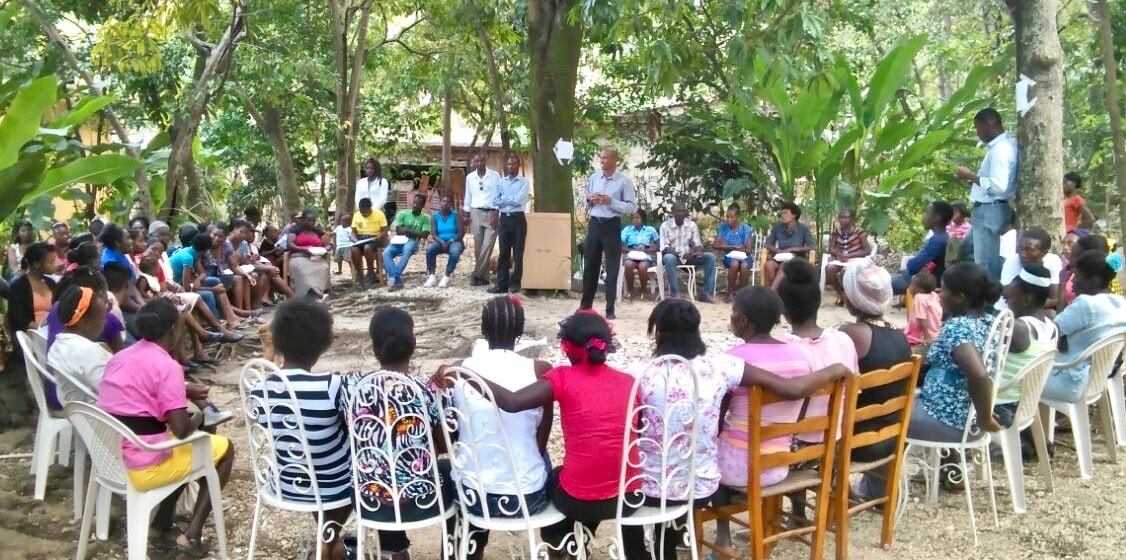
By John Engle.
My years of work in Haiti, prior to opening the Children’s Academy with Merline, Alex Myril and members of the community, were spent learning and helping others to learn, how to create conditions for engagement. Haitians and expats working in Haiti have all seen countless examples of projects that don’t work. More often than not the cause of failure was the result of a fundamental error in the structuring of the project: it was imposed by people outside of the community, people who are unfamiliar with the area and who would not be involved in its ongoing success.
Committed to learning techniques for creating conditions that foster people fully investing in and owning project outcomes, I studied, attended international seminars and accompanied experts. One of the methods that I became a practitioner of in the early 90s was open space technology. Perhaps you are familiar with this method where you have a theme but no agenda. People convene because they’re interested in the theme. It might be 10 people or it might be 2000. It takes the facilitator about 15 minutes to center the group on the theme, explain the principles that will guide their time together, and then invite participants to come forth proposing topics that they wish to address with others who are interested.

In addition to becoming an expert at this method, I also helped dozens of Haitians to become experts. In turn, they trained hundreds of others.
The use of open space technology in running meetings, helps a group evolve over time in such a way that the participants are empowered to take initiative and live into their leadership potential.
Haiti’s earthquake in 2010 caused untold destruction and hardship that would prove to have far reaching implications. An incident occurred in our community where local people accused several Europeans of trying to contaminate the local water source with cholera. They were attacked with machetes and rocks and had it not been for several brave Haitians in our community and then the arrival of Merline and Alex, they would have surely been killed. While the two couples who had worked for UNICEF and other international agencies were not seriously harmed, they were traumatized and moved away from Haiti the following week. Word quickly spread throughout our community what had happened and most people were absolutely horrified. Many of us saw it as an opportunity for collective learning and healing.
Before leaving Haiti the couple wrote a letter explaining that they were simply out for a hike on a Sunday morning in the beautiful mountains where we live. They shared that they had originally come to Haiti to assist in improving the country. To do something that would harm Haitians … this was the furthest thing from their minds. They also expressed that they can understand, because of wrongdoings by others, when Haitians are leery of foreigners. They also expressed profound gratitude to those who risked their lives to save theirs. They concluded in sharing that they hoped this experience could foster collective learning, growth and healing in our community that would make us all stronger together in moving forward.

We made numerous copies of the letter and distributed it to all the local pastors, the Catholic priest and other community leaders. We requested that the letter be read to their congregations. As those two couples hoped, their experience did indeed lead to collective learning and growth. It also led to us establishing a monthly community meeting–the 2nd Sunday of every month at 2:00 pm. Nine years later, it’s still happening every single month sometimes with as few as 15 people and sometimes with as many as 200 or more. We started these community meetings at the local Catholic Church. The priest was very keen on the idea and was happy to host. Once the Children’s Academy was finished, we continued them there.
From the outset, we used a modified version of the open space method for these meetings, meaning that we typically did not break into small groups. We simply invited people to propose agenda items and we built an agenda together that we’d also address together, point by point.
As these meetings unfolded, in addition to people expressing their frustrations about what needs to change in our community, they also began expressing their dreams for the community. Having a fabulously effective school in preparing and inspiring our children for the future and supporting their families with education as well, and a health clinic became the two main priorities. And it’s here that the community birthed the idea of a unique school-based community development model which became, the Children’s Academy and Learning Center.
Haiti Partners
PO Box 7882
Delray Beach, FL 33482
Email: hello@haitipartners.org
Phone: (772) 539-8521